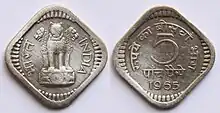Indian 5-paisa coin
The Indian five paise (Hindi: पाँच पैसे) (singular: Paisa), is former denomination of the Indian Rupee. The 5![]() coin equals 1⁄20 of the Indian Rupee. The symbol for paisa is (
coin equals 1⁄20 of the Indian Rupee. The symbol for paisa is (![]() ).
).
India | |
| Value | 5 |
|---|---|
| Mass | 1.03 g (15.9 gr) |
| Diameter | 22 mm (0.87 in) |
| Thickness | 1.5 mm (0.06 in) |
| Composition | Cupronickel Aluminium & Aluminium-magnesium |
| Years of minting | 1964–1994 |
| Mintage | 4,924,011,110.[1][2][3] |
| Mint marks | ⧫ = Mumbai B = Mumbai proof issue * = Hyderabad No mark = Kolkata |
| Circulation | Demonetized |
| Catalog number | KM 17, KM 18.1 to 18.6 KM 19, 20, 21, 22 & 23 |
| Obverse | |
 | |
| Design | State Emblem of India with country name. |
| Reverse | |
| Design | Face value and year. |
History
Prior to 1957, Indian rupee was not decimalised and the rupee from 1835 to 1957 AD was further divided into 16 annas. Each anna was further divided to four Indian pices and each pice into three Indian pies till 1947 when the pie was demonetized. In 1955, India amended the "Indian Coinage Act" to adopt the metric system for coinage. Paisa coins were introduced in 1957, but from 1957 to 1964 the coin was called "Naya Paisa" (English: New Paisa. Plural: Naye paise). On 1 June 1964, the term "Naya" was dropped and the denomination was simply called "One paisa" (or paise for denomination greater than one). Paisa coins were issued as a part of "The Decimal Series".[4][5][6] Five paise coins were minted from 1964 to 1984.[1] 5 paise was equivalent to four-fifths of an anna (0.8 anna).
Mintage
Five paise coins were minted from 1961 to 1984 at the India Government Mints in Mumbai, Kolkata and Hyderabad.[1][2][3] The coins were demonetized in 1994.[6]
Mint marks
Depending on the mint producing the coins, following mint marks appear:
| Mint | Mark | Description | Comments |
|---|---|---|---|
| Hyderabad | ☆ | Five-pointed star | |
| Kolkata | No mint-mark | Since this was the first Indian mint, coins minted in Kolkata don't carry a mark.[7] | |
| Mumbai | ⧫ | Diamond | |
| • | Small dot (solid) | ||
| B | Letter B below year | ||
| M | Letter M below year | On coins minted after 1996. | |
| Noida | ° | Small dot (hollow) | |
Composition
Five paise coins were minted from Cupronickel, Aluminium and Aluminium-magnesium in medallic alignment. The coins were rhombus shaped and had smooth edge.[1][2][3]
- 1964-1966: Cupronickel.
- 1967-1984: Aluminium.
- 1984-1994: Aluminium-magnesium.
Variants
| 5 paise coin variants (1964-1994). | |||||||||||||
|---|---|---|---|---|---|---|---|---|---|---|---|---|---|
| Image | KM# | Technical parameters | Description | Year of minting | Comments | ||||||||
| Obverse | Reverse | Weight | Diameter | Thickness | Metal | Edge | Obverse | Reverse | First | Last | |||
| 17 | 4.05 g | 22 mm | 2.2 mm | Cupronickel | Smooth | State Emblem of India & country name in Hindi and English. | Face-value, year and lettering रूपये का बीसवाँ भाग; (E: 20th part of a rupee) | 1964 | 1966 | [3][6] | |||
| 18.1 | 1.6 g | Aluminium | 1967 | 1967 | Number 5 on reverse smaller in size.[1] | ||||||||
| 18.2 | 1.6 g | 1967 | 1971 | Arms type 1. Number 5 on reverse larger in size.[1] | |||||||||
| 18.3 | 1.6 g | 1967 | 1971 | Arms type 2. Number 5 on reverse larger in size.[1] | |||||||||
| 18.4 | 1.53 g | 2.0 mm | Face-value, year and lettering. | 1972 | 1972 | Hindi lettering on reverse omitted.[1] | |||||||
| 18.5 | 1.53 g | 1973 | 1978 | Arms type 1. Number 5 on reverse larger in size.[1] | |||||||||
| 18.6 | 1.53 g | 1972 | 1984 | Arms type 2. Number 5 on reverse larger in size.[1] | |||||||||
| 23a | 1.03 g | 1.5 mm | Aluminium- magnesium | 1984 | 1994 | Lightest 5 paise coin.[4] | |||||||
See also
References
- "5 paisa variants". colnect.com. Retrieved 31 August 2017.
- "5 paisa commemorative". colnect.com. Retrieved 31 August 2017.
- "5 paisa cupronickle". colnect.com. Retrieved 31 August 2017.
- "Coin details". India Numismatics. Retrieved 31 August 2017.
- "Republic India Coinage". Reserve Bank of India. Retrieved 31 August 2017.
- "History of Indian coins". India Numismatics. Retrieved 31 August 2017.
- "Mint marks". indian-coins.com. Retrieved 31 August 2017.